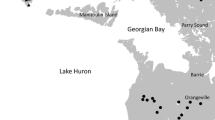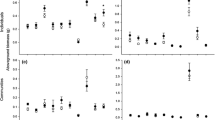Abstract
One of the characteristics of highly invaded ecosystems is that exotic species are often poor invaders of edaphically severe sites, which become refuges for native flora. To investigate the invasive potential of Lolium multiflorum (Per.) into alkali sites in California, an ex-situ reciprocal transfer experiment was carried out using seeds from populations of L. multiflorum taken from three sites differing in alkalinity (and inundation), including alkali sink soils (pH 8.5) and sink matrix soils (pH 7.4) located within meters of each other, and non-sink soils (pH 5.0) located several km away. Survivorship, plant height, leaf number and seed production were assessed. In addition, a native composite, Hemizonia pungens (Hick.), commonly found on alkali sinks was also sampled at the sink and sink matrix microsites. Lolium multiflorum plants grown from alkali sink and sink matrix seeds produced fewer leaves and seeds but were taller than plants grown from non-alkali seeds, the latter perhaps an adaptation to frequently inundated soils. Non-alkali genotypes fared poorly in sink soils for all traits, both in comparison to their growth on non-sink soils, and in comparison to the sink and sink edge genotypes. This suggests the existence of L. multiflorum ecotypes adapted to inundated alkali sinks, a genotypic difference that occurs on a broad spatial scale (kilometers), but not so obviously on the micro-site scale (meters) between sink and sink matrix populations. These data suggest that the absence of exotic invasives from alkali sites may be temporary if they are evolving tolerance for these severe sites, and this may threaten the future of the native alkali specialists that currently find refuge in these sites.
Similar content being viewed by others
References
Agriculture and Agri-food Canada (1999) Strategies for avoiding herbicide resistance in ryegrasses. Research Letter No. 99–01. Retrieved from http://www.res2.agr.ca/saskatoon/result/letter9901-letter9901_e.htm on 4 December 2005
Bennington CC, McGraw JB (1995) Natural selection and ecotypic differentiation in Impatiens pallida. Ecological Monographs 65:303–323
Berglund ABN, Dahlgren S, Westerbergh A (2004) Evidence for parallel evolution and site-specific selection of serpentine tolerance in Cerastium alpinum during the colonization of Scandinavia. New Phytologist 161:199–209
Bradshaw AD (1984) Ecological significances of genetic variation between populations. In: Dirzo R, Sarukhán J (eds) Perspectives on plant population ecology. Sinauer Associates Inc., Sunderland, pp 213–228
Brady KU, Kruckeberg AR, Bradshaw H (2005) Evolutionary ecology of plant adaptation to serpentine soils. Annual Review of Ecology, Evolution, and Systematics 36:243–266
Briggs D, Walters SM (1984) Plant Variation and Evolution, 2nd edn. Cambridge University Press, Cambridge
Brown CS, Rice KJ (2000) The mark of Zorro: effects of the exotic annual grass Vulpia myuros on California native perennial grasses. Restoration Ecology 8:10–17
California Exotic Pest Plant Council (1999) Exotic plant pest list. Retrieved from http://www.ucce.ucdavis.edu/files/filelibrary/5319/4898.pdf on October 19, 1999
Cheplick GP (1988) Influence of environment and population origin on survivorship and reproduction in reciprocal transplants of Amphicarpic Peanutgrass (Amphicarpum purshii). American Journal of Botany 75:1048–1056
Chornesky EA, Randall JM (2003) The threat of invasive alien species to biological diversity: setting a future course. Annals of the Missouri Botanical Garden 90:67–76
Clausen J, Keck DD, Heisey WM (1940) Experimental studies on the nature of species. I. The effect of varied environments on Western North American plants. Carnegie Institution of Washington Publication No. 520, Washington D.C
Cox GW (2004) Alien species and evolution. Island Press, Washington DC, USA
Dulloo ME, Kell SR, Jones CG (2002) Impact and control of invasive alien species on small islands. International Forestry Review 4:277–285
Dyer AR, Rice KJ (1997) Intraspecific and diffuse competition: the response of Nassella pulchra in a California grassland. Ecological Applications 7:484– 492
Dyer AR, Rice KJ (1999) Effects of competition on resource availability and growth of a California bunchgrass. Ecology 80:2697–2710
Galloway LF, Fenster CB (2000) Population differentiation in an annual legume: local adaptation. Evolution 54:1173–1181
Gelbard JL, Harrison S (2003) Roadless habitats as refuges for native grasslands: interactions with soil, aspect, and grazing. Ecological Applications 13:404–415
Gerhardt F, Collinge SK (2003) Exotic plant invasions of vernal pools in the Central Valley of California, USA. Journal of Biogeography 30:1043–1052
Gram WK, Borer ET, Cottingham KL, Seabloom EW, Boucher VL, Goldwasser L, Micheli F, Kendall BE, Burton RS (2004) Distribution of plants in a California serpentine grassland: are rocky hummocks spatial refuges for native species? Plant Ecology 172:159–171
Hannaway D, Fransen S, Cropper J, Teel M, Chaney M, Griggs T, Halse R, Hart J, Cheeke P, Hansen D, Klinger R, Lane W (1999) Annual ryegrass (Lolium multiflorum Per.). Retrieved from http://www.eesc. orst.edu/agcomwebfile/edmat/html/pnw/pnw501/intro.html on 5 December 2005
Harrison S (1999) Native and alien species diversity at the local and regional scales in a grazed California grassland. Oecologia 121:99–106
Heady HF (1988) Valley grassland. In: Barbour MG, Major J (eds) Terrestrial vegetation of California. J. Wiley-Interscience, New York, pp 491–514
Hellmers H, Ashby WC (1958) Growth of native and exotic plants under controlled temperatures and in the San Gabriel Mountains California. Ecology 39:416–428
Hickman JC (ed) (1993) The Jepson Manual of Higher Plants of California. University of California Press, Berkley, CA, USA,1400 pp
Joshi J, Schmid B, Caldeira MC, Dimitrakopoulos PG, Good J, Harris R, Hector A, Huss-Danell K, Jumpponen A, Minns A, Mulder CPH, Pereira JS, Prinz A, Sherer-Lorenzen M, Siamantziouras ASD, Terry AC, Troumbis AY, Lawton JH (2001) Local adaptation enhances performance of common plant species. Ecology Letters 4:536–544
Kawecki T, Ebert D (2004) Conceptual issues in local adaptation. Ecology Letters 7:1225–1241
Kay BL, Love RM, Slayback RD (1981) Revegetation with native grasses: a disappointing history. Fremontia 9:11–15
Kruckeberg AR (1951) Intraspecific variability in the response of certain native plant species to serpentine soil. American Journal of Botany 38:408–419
Leiss KA, Müller-Schärer H (2001) Performance of reciprocally sown populations of Senecio vulgaris from ruderal and agricultural habitats. Oecologia 128:210–216
Linhart YB (1988) Intrapopulation differentiation in annual plants 3. The contrasting effects of intraspecific and interspecific competition. Evolution 42:1047–1064
Marty JT (2005) Effects of cattle grazing on diversity in ephemeral wetlands. Conservation Biology 19:1626–1632
McGraw JB, Chapin FS III (1989) Competitive ability and adaptation to fertile and infertile soils in two Eriophorum species. Ecology 70:736–749
Montalvo AM, Ellstrand NC (2000) Transplantation of the subshrub Lotus scoparius: testing the home-site advantage hypothesis. Conservation Biology 14:1034–1045
Prasada R, Power JF (1997) Soil Fertility Management for Sustainable Agriculture. Lewis Publishers, NY, NY
Primack RB, Kang H (1989) Measuring fitness and natural selection in wild plant populations. Annual Review of Ecology and Systematics 20:367–396
Vasquez EA, Glenn EP, Brown JJ, Guntenspergen GR, Nelson SG (2005) Salt tolerance underlies the cryptic invasion of North American salt marshes by an introduced haplotype of the common reed Phragmites australis (Poaceae). Marine Ecology-Progress Series 298:1–8
Vitousek PM., D’Antonio CM, Loope LL, Rejmanek M, Westbrooks R (1997) Introduced species: a significant component of human-caused global change. New Zealand Journal of Ecology 21:1–16
Wilcove DS, Rothstein D, Dubrow J, Phillips A, Losos E (1998) Quantifying threats to imperiled species in the United States. BioScience 48:607–615
Williamson J, Harrison S (2002) Biotic and abiotic limits to the spread of exotic revegetation species. Ecological Applications 12:40–51
Zedler PH, Black C (2004) Exotic plant invasions in an endemic-rich habitat: The spread of an introduced Australian grass, Agrostis avenacea J. F. Gmel., in California vernal pools. Austral Ecology 29:537–546
Acknowledgements
Sincerest thanks go to Ron Lane and the staff at the Environmental Horticulture Greenhouse, UC Davis. We also thank Richard Evans, John McKay, Marcel Rejmanek, Jim Richards, the staff of DANR lab UC Davis, and Cliff Feldheim of the Alkali Grasslands Preserve, Center of Natural Lands Management for all their help and advice. John McKay and anonymous reviewers commented on the ms.
Author information
Authors and Affiliations
Corresponding author
Rights and permissions
About this article
Cite this article
Dawson, K., Veblen, K.E. & Young, T.P. Experimental evidence for an alkali ecotype of Lolium multiflorum, an exotic invasive annual grass in the Central Valley, CA, USA. Biol Invasions 9, 327–334 (2007). https://doi.org/10.1007/s10530-006-9036-2
Received:
Accepted:
Published:
Issue Date:
DOI: https://doi.org/10.1007/s10530-006-9036-2




